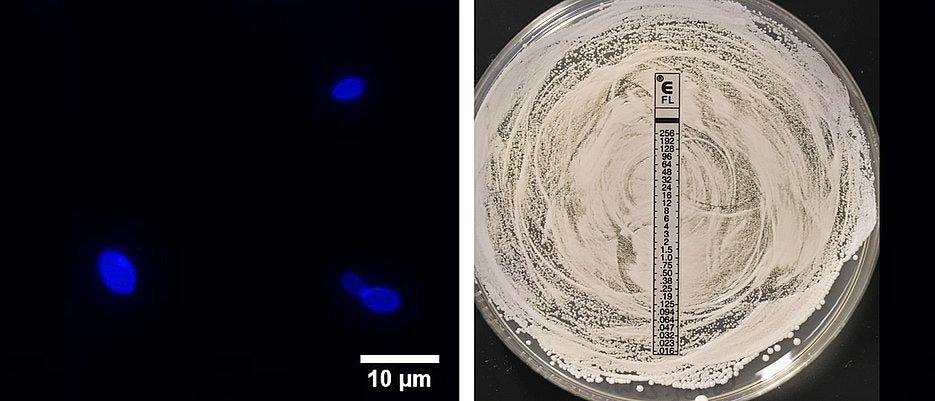Candida auris is an extremely new species among yeasts from the Candida genus that cause infections in humans: it was only reported in 2009, and no evidence has been found prior to the 1990s. It is unknown what ecological niche C. auris inhabits and why human infections have increased since the millennium’s turn.
 Infections with Candida auris are difficult to treat and potentially life-threatening. The picture shows yeast cells of C. auris on the left and a fluconazole-resistant C. auris strain on the right. Image Credit: Alexander Aldejohann.
Infections with Candida auris are difficult to treat and potentially life-threatening. The picture shows yeast cells of C. auris on the left and a fluconazole-resistant C. auris strain on the right. Image Credit: Alexander Aldejohann.
The pathogen’s ability to acquire resistance to all current antifungal classes complicates the treatment of C. auris infections. Furthermore, unlike other Candida species, C. auris can be rapidly spread from patient to patient by direct and indirect contact, resulting in difficult-to-control hospital outbreaks.
Dramatic Increase in the USA
Such outbreaks are now being reported all throughout the world, including in England, Spain, and Italy. In April 2023, the United States experienced a huge spike in C. auris infections, as well as continued resistance development. A recent European Centre for Disease Prevention and Control report also showed a considerable increase in case numbers throughout Europe.
As a result, the US Centers for Disease Control categorizes C. auris as an “urgent threat”—the highest prioritization category within multidrug-resistant pathogens. C. auris is also listed as one of only four pathogens with the highest priority level in the World Health Organization’s 2023 list of fungi that cause human infections.
Increase in Case Numbers Also in Germany
Since 2015, only a few isolated instances of C. auris have been reported in Germany. However, according to a new study published in the Deutsches Ärzteblatt, the number of cases in Germany has also soared in recent years.
Dr Alexander Aldejohann of the Julius-Maximilians-Universität Würzburg (JMU) Institute for Hygiene and Microbiology and researchers from the National Reference Center for Invasive Fungal Infections (NRZMyk) and the Robert Koch Institute were involved for in this study. Professor Oliver Kurzai, Director of the Institute of Hygiene and Microbiology and Head of the NRZMyk, also participated.
The analysis is based on a comparison of C. auris data from the NRZMyk and the Robert Koch Institute’s antibiotic resistance surveillance network. By the end of 2022, the two databases had documented 43 C. auris cases. Colonization was found in 19 cases, while infection necessitated treatment in 16 others. A stay abroad was reported in about 42% of the cases, just before the infection was discovered.
Resistant to Common Drugs
Fluconazole, a commonly used antifungal drug, was highly resistant to 80% of the fungal strains available at NRZMyk. Resistance to echinocandin, a relatively new class of substances used to treat fungal infections, was found in one case. Infections transmitted to patients in connection with a medical procedure, such as in hospitals, care facilities, or outpatient practices, were also recorded in the data analysis for 2021 and 2022 in Germany.
In conclusion, the authors conclude that the absolute number of C. auris infections in Germany is still low. However, they believe that the large increase in the number of infections over the last two years, as well as the discovery of the first transmission incidents in Germany, should be read as an alarm signal.
Comments on the Publication
Compared to other European countries such as Spain, Italy, or Great Britain, the case numbers in our country are fortunately still low. We must do everything we can to keep it that way for as long as possible - our experience shows that any infection with Candida auris is difficult to treat and potentially life-threatening for patients. However, the good news at the moment is that no patient in a German hospital has to be afraid of becoming infected with Candida auris.”
Dr Alexander Aldejohann, Specialist, Microbiology, Virology and Infectious Disease Epidemiology, Institute of Hygiene and Microbiology, University of Würzburg
“Our analyses show—fortunately still at a very low level—a significant increase in C. auris imports into Germany. At the same time, we were able to prove that the cases are currently not completely recorded in any database—we have to assume an unreported number,” says Prof. Dr. Oliver Kurzai, Chair of Medical Microbiology and Mycology, University of Würzburg and Head, NRZMyk.
“In view of the fact that we are also already finding the first transmission events in Germany, I have recommended to the Robert Koch Institute the introduction of a statutory laboratory reporting requirement for the detection of C. auris,” says Prof. Dr. Oliver Kurzai.
“In my view, this can be implemented with reasonable effort and, in addition to a precise recording of the epidemiology, would also make it possible to initiate infection protection measures at an early stage in the event of detection,” concludes Prof. Dr. Oliver Kurzai.
Source:
Journal reference:
Ärzteblatt, D. Ä. G.& Redaktion Deutsches. (2023). Anstieg von Candida-auris-Fällen und erste nosokomiale Übertragungen in Deutschland. Deutsches Ärzteblatt. www.aerzteblatt.de/archiv/231188.